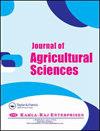Comparison of Bread Wheat Genotypes for Leaf Rust Resistance Genes
IF 0.7
Q3 AGRICULTURE, MULTIDISCIPLINARY
引用次数: 1
Abstract
Leaf rust caused by Pucinia recondita tritici is one of the most important diseases of bread wheat worldwide. It is considered that the most environmentally sound; low cost method of controlling leaf rust is to breed and grow genetically resistant wheat varieties. In the research, twenty-four bread wheat varieties grown intensively were used as genetic material in Trakya Region where the North-West Part of Turkey. To create artificial leaf rust epidemic in field conditions, two sensitive varieties (Morrocco and Cumhuriyet 75) was sown after each ten genotypes, and the reactions of the varieties to leaf rust were investigated in field conditions. Isogenic lines carrying the genes Lr9, Lr14, Lr19, Lr24 and Lr47 from CIMMYT were used as control genotypes in molecular analysis. In the field conditions, although Pehlivan, Selimiye, Sagittario, Tina, Anapo, Montchill and Saraybosna were the most sensitive genotypes, Nota, Kate A1, Prostor and Sana were the most resistant bread wheat varieties to leaf rust. It was determined that Sana, Pehlivan, Golia, Falmura 85, Saroz 95, Renan, Sirena, Kate A1, Selimiye, Bezostoja 1, Saraybosna, Nina and Tina varieties have Lr9 gene with SSR analysis. It has been observed that all bread wheat varieties carry Lr14, Lr19, Lr24 and Lr47 (except Krasunia, Aldane and Gelibolu varieties) genes. It is revealed that Lr9 and Lr47 genes should be taken into consideration in the studies to be performed in the region and these genes will be useful to examine together with a larger number of leaf rust genes for more successful results in breeding studies.面包小麦抗叶锈病基因型比较
小麦叶锈病是面包小麦的主要病害之一。人们认为最无害环境;低成本防治叶锈病的方法是选育抗叶锈病的小麦品种。在这项研究中,在土耳其西北部的Trakya地区集约种植的24个面包小麦品种被用作遗传物质。为了在田间条件下制造叶锈病人工流行,在10个基因型后分别播种2个敏感品种(摩洛哥和Cumhuriyet 75),并在田间条件下调查了这些品种对叶锈病的反应。以携带CIMMYT Lr9、Lr14、Lr19、Lr24和Lr47基因的等基因系作为对照基因型进行分子分析。在田间条件下,尽管Pehlivan、Selimiye、Sagittario、Tina、Anapo、Montchill和Saraybosna是最敏感的基因型,但Nota、Kate A1、Prostor和Sana是对叶锈病最抗性的面包小麦品种。经SSR分析,Sana、Pehlivan、Golia、Falmura 85、Saroz 95、Renan、Sirena、Kate A1、Selimiye、Bezostoja 1、Saraybosna、Nina和Tina品种均含有Lr9基因。除Krasunia、Aldane和Gelibolu品种外,所有面包小麦品种均携带Lr14、Lr19、Lr24和Lr47基因。结果表明,Lr9和Lr47基因在该地区的研究中应该考虑到,这些基因将有助于与更多的叶锈病基因一起进行研究,以获得更成功的育种研究结果。
本文章由计算机程序翻译,如有差异,请以英文原文为准。
求助全文
约1分钟内获得全文
求助全文
来源期刊

Journal of Agricultural Sciences
AGRICULTURE, MULTIDISCIPLINARY-
CiteScore
1.80
自引率
0.00%
发文量
0
 求助内容:
求助内容: 应助结果提醒方式:
应助结果提醒方式:


